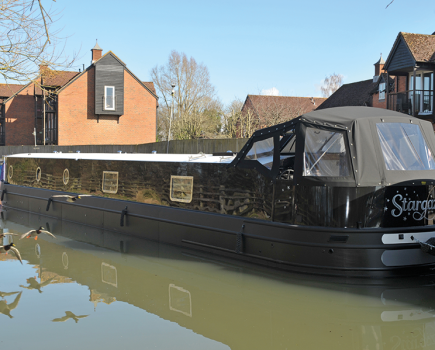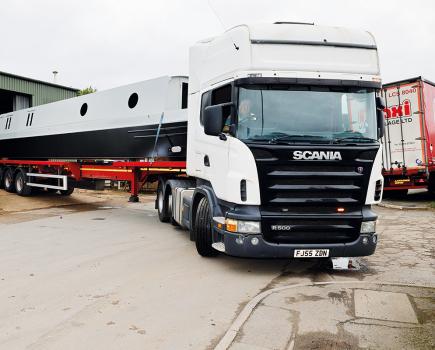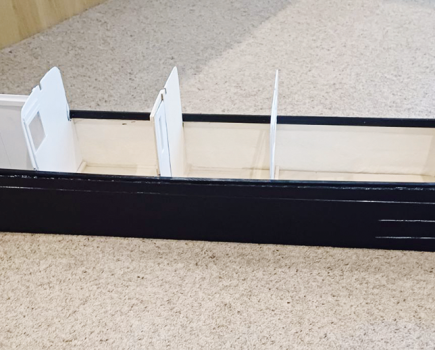It’s a great-looking trad, but it has a brand spanking new modern engine – and a decent price

There’s a misconception that if you want a traditional looking boat, you have to go the whole hog and have a back cabin, an engine room and a vintage engine. And while some people lust after a loud, low-revving power plant, they’re not for everyone.

But here’s a boat which proves that there is another way. It has very traditional lines on the outside, with its rivets and recessed panels, and the pigeon box on the roof might suggest an engine room, too. But it is, in fact, powered by a brand spanking new modern engine, hidden under the floor at the rear. It’s also a boat that’s shorter than you might think, at just 55ft, proving that you don’t need 60ft or more to fit everything in.

It’s built by SM Hudson, one of the longest established names in the boat building industry, and one of those builders who does everything from the base plate to the paintwork.

Steve Hudson is a builder with a reputation for good quality steelwork and fit-outs, but this boat also proves something else: quality doesn’t cost as much as you might think.

EXTERIOR
You can spot a Hudson coming towards you a mile off, and that’s all down to the firm’s distinctive steelwork.
The bow is the most recognisable feature. It’s described as a Josher – but really, a much better description would be to call it a Hudson. It has all the curves you’d expect; it’s long but also quite high; it’s sleek but at the same time very substantial.
To appreciate the classic traditional lines of the rest of the shell, it’s best to stand back and take in the whole thing. The gunwales rise towards the bow and the stern, and the cabin top also rises at the stern. This sheerline is subtle and it looks just right.
Poppy has the firm’s highest specification of steelwork, so there’s interesting decoration and detailing everywhere. Some are obvious (like the rivets, the recessed panels and the stop beam), but some are quite hard to spot. For example, there’s a feature groove on the bow and there’s another all the way along the boat below the handrail. Other bow detailing includes a cutaway cant and a Josher style T-stud.
At the stern, the rear bulkhead has simulated planking, while the Josher-style dollies are made to look as though they’re bolted on. There’s also a substantial square boss at the base of the swan neck. The tiller is meaty and the rudder large and heavy.
The gas locker is, as you’d expect, in the bow and a stainless steel water tank sits under the well deck. There’s also a hatch to give access to the bow thruster tube, and there are lockers with lids down each side of the well deck. As this is a rear-engined boat (rather than having a back cabin with an engine room beyond) it has a longer sliding hatch at the stern, to make getting in and out a bit easier.
The pigeon box on the roof is in roughly the same position it would occupy if this boat had an engine room, but its purpose is entirely different because it doesn’t actually cover a roof vent. Instead, it hides the shorepower plug, a great way of disguising what would otherwise be a modern carbuncle on this traditional face.
The paintwork and signwriting are both done in house and to a very high standard. The colour scheme of green panels with black surrounds works well; the gunwale tops are traditional raddle red, as are the decks and the roof aft of the boatman’s beam. The signwriter has done a good job decorating this boat with poppies, both in the name panel and inside the front and side doors. All the trim, such as portholes, mushroom vents, Houdini hatch and fairleads are brass, to complement the traditional look.
But as important as what you can see, is what you can’t – what’s below the skin and hidden by the fit-out. Here there’s a 15mm base plate and a keelson running the length of the boat with the floor bearers coming off it. Hudson’s are generous with the amount of framing used in the construction, particularly on the roof. The stem post is a solid piece of steel, 40mm by 70mm and all this makes for a very solid shell.
LAYOUT AND FIT-OUT
Poppy has a standard layout, so there’s a saloon at the bow, followed by a breakfast bar and a U-shaped galley. A corridor with a door at each end leads past a shower room, with the cabin beyond. At the stern there’s the ‘engine room’.
The fit-out uses American light oak with vertical tongue and groove below the gunwales and horizontal runs above. The woodwork looks good and the furniture is well made. The floor is the hard-wearing favourite, Karndean.
SALOON
A set of ladder-style steps leads down from the well deck into the saloon. It’s a room that has been left largely clear for free-standing furniture. The owner is planning to have a small sofa and a table.
In one corner there’s a Squirrel stove on a hearth with tiled walls right up to the ceiling. On the other side of the boat there’s a long unit. It starts with a corner cupboard with a car radio inside and a high-level corner unit above. The top of the cupboard is a thick piece of oak that extends down the boat to give a broad shelf. Underneath there’s a radiator, complete with a pierced cover, and another cupboard, this time with a glazed door. Shelves extend from the unit.
This is an all-porthole boat, so there’s a prism in the roof which is a great way of letting in some extra light. There are also lots of lights set into the ceiling, with each pair having their own switch. They have halogen bulbs, though, which will use a lot more power than the LED equivalents. Making the change would be a simple task.
GALLEY
On the saloon side of the galley there’s a breakfast bar, which will have a couple of stools. Underneath, making use of the otherwise dead corner, a washing machine is hidden behind a door and there’s a matching false door alongside.
The main part of the galley is U-shaped. The worktops and sink are made from Avonite laminate and should prove very durable. The sink has a smart arched tap while the splashback is made of attractive tiles with a brick pattern. There are also high-level cupboards on this side.
The cupboard doors are well made and one hides a 12v Shoreline fridge. There’s also a Thetford oven and grill, with a Spinflo four-burner hob above.
Opposite the galley is a set of side doors, with nicely scumbled and painted panels, and glazed inner doors. A can cupboard is tucked underneath the gunwales.
A Houdini hatch lets the light flood in.
SHOWER ROOM
The shower room is off-corridor, although the corridor has doors at each end.
The room itself is compact without being cramped. The shower is 700mm square and lined with tiles, again in a brick pattern. The shower drains into a sump box with an automatic pump. Alongside there are a couple of cupboards which, as well as providing storage space, provide access to the plumbing – for example, the base of the lower cupboard lifts out so you can get to the sump.
On the other side of the room there’s a good sized storage unit, with an Avonite worktop and a smart white basin with a mirror above and a high-level cupboard. The loo is a Dometic drop-through, a low-tech option that shouldn’t let you down. The stainless steel holding tank is under the bed in the cabin, on the centre line so the boat won’t list as it fills.
Finishing off, there’s a chrome heated towel rail, and the mushroom vent includes an extractor fan.
CABIN
The bed is in-line and 4ft wide. The pump-out tank takes up a good proportion of the space underneath, but there’s long term storage on the far side. There’s a proper footboard, complete with a bedpost.
For a relatively small bedroom there’s lots of storage space. High-level cupboards sit above the head and side of the bed; there’s a large wardrobe at the foot and, in the opposite corner, there’s a dressing table with a mirror and a matching high-level cupboard. Above the radiator there’s a wide shelf.
ENGINE ROOM
A step leads from the cabin to the engine room. It flips up and locks in place, out of the way, so the cabin door can be closed.
The engine is under the floor, which is made of hard-wearing boards. More lifting boards either side give access to the batteries and the boiler. To one side there’s an electrical cupboard.
A chunky step at the rear provides somewhere for the helmsman to stand on, and the stern tube greaser is conveniently positioned underneath.
At the moment, in its pristine condition, this engine room looks a bit empty; no doubt it won’t be long before it’s like every other trad engine room: full of coats, boots, ropes, fenders, and goodness knows what else.
TECHNICAL
This boat might look very traditional on the outside, but it’s powered by a modern engine, a Beta Marine 43, one of the most popular engines for canal boats. But lift the boards in the engine room and you’re in for a shock, because what greets you is not the familiar Beta green but a shimmering silver engine. Steve Hudson has his Betas painted silver at the factory, as a special order, because he thinks they look nicer that way.
Whatever the colour, access to a modern trad’s engine can sometimes be tricky. In this boat, not only do the boards over the engine lift out, so does the vertical one between the cabin and the engine hole. “We do lots of maintenance on boats,” says Steve Hudson, “so we like to make sure we can get to everything.” This arrangement means that all the filters that need to be changed regularly are easily accessible.
There are four 110Ah domestic batteries, plus one for the engine and two for the bowthruster, which is a 95kgf Vetus. A 240-volt supply comes from a Mastervolt 2.5kW combi inverter/charger.
Heating is by a 5kW Eberspacher diesel boiler. The calorifier is right next to it in the engine hole.
ON THE WATER
Steering this boat is a thoroughly enjoyable experience. From the steerer’s step just inside the hatch, you have a commanding view ahead over the cabin.
The tiller is quite heavy to move, due in part to the size and thickness of the rudder, but that’s not a criticism: it feels very positive and the boat responds well. In addition, the rudder post is set at an angle, so the rudder centres itself after a turn, and the boat will stay in a straight line if you let go of the tiller. Long swims fore and aft mean that Poppy handles very well and with little or no wash. When you’re winding, once the spin has started, it keeps going remarkably easily. It’s a heavy boat, so it feels solid and reliable, and won’t do anything unpredictable. In short, it’s one of the best handling boats we’ve come across in a long time.
If you need a little extra help with manoeuvring, the Vetus bowthruster provides plenty of oomph. At 95kgf it’s more powerful than those fitted in many boats, and it’s all the better for it.
The Morse control is well sited, as are the bowthruster buttons, but the rev counter is positioned a little low to see easily.
The boat is remarkably quiet, especially when you consider that there’s no sound insulation in the engine hole and no hospital silencer. It illustrates how quiet a Beta 43 really is. And adding some insulation on the underside of the deck boards would reduce the noise level to virtually nothing.
CONCLUSION
This is a boat with excellent steelwork and a solid, no-nonsense fit-out. It’s proof that you can have a boat with pleasing traditional lines on the outside, but still enjoy the convenience of a modern engine and electrics.
The price might come as a surprise too. While SM Hudson builds bespoke boats, many of them are based on a variety of standard specifications, which cover both the steelwork and the interior. Taking that spec as a starting point, you can add or subtract almost anything. Poppy is based on the highest spec, which for a 55ft boat costs £101,500. There are a number of additions, including the bowthruster, the Avonite worktops and the inverter (the latter of which is probably essential), which brings the price to around £110,000.
We like this boat; it’s proof, if any were needed, that quality, traditional workmanship need not cost as much as you might think.
Image(s) provided by:
Archant







